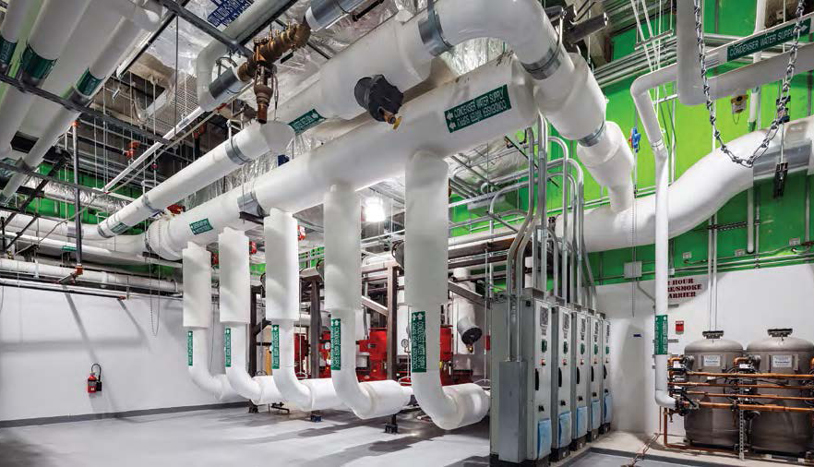THE POSSIBILITIES OF SMART BUILDINGS

After building an award-winning smart building system together more than two years ago, former project partners Doug Kruser, Structure Tone project manager and mechanical specialist, John Hester, owner and chief consultant at Hester Consulting, and Michael Krall, executive director of smart buildings at JPMorgan Chase, reconnected to reflect on their experience and how the world of smart buildings has advanced since then.
What is a smart building?
Hester: In traditional buildings, each building system—like lighting, HVAC, and power—operates on its own network, and is connected on a point-to-point cabling basis from their sensors to the front end. In a smart building, all of the systems are connected via the internet to a common front end.
Krall: What really makes a smart building “smart” is breaking down the silos between the building management systems. When you can put the data from those systems onto a common network, the information generated can create tons of insights and trigger sequences within the building.
Kruser: As a contractor, our first mission is to install all the cables. Then the smart building consultants can establish future applications to utilize that data.
Are there any risks when implementing a smart building system?
Hester: Yes, cybersecurity is extremely important. In a smart building, all the building systems communicate with one another, which means each system also represents potential entry points for hackers.
Kruser: This hasn’t been a concern in the past because typically each system would operate within its own proprietary network. When they’re all riding a common fiber backbone, every piece of equipment and every system has to be tested to make sure the network is secure.
How does implementing a smart building system affect facilities management teams?
Krall: One of the biggest challenges for facilities teams is understanding the operations from a network perspective. For instance, in a nonsmart building, if there is an issue with an air handler, the facilities team would call the vendor that installed that air handler. In a smart building, the issue might not be the air handler itself—it could be the switch, a port configuration, or even cybersecurity that’s shut something down, so understanding that operational shift is critical.
Are smart building systems worth the investment?
Hester: A well-planned, well-designed smart building system will be able to collect data from multiple systems throughout the building and share that information across a common front end, which eliminates the need for users to switch from one platform or program to another. These systems can also often identify, alert, and dispatch personnel to address detected anomalies.
Kruser: We’ve even seen clients incorporate predictive software tools that alerts facilities management when it detects a potentially faulty piece of equipment before anything breaks.
Krall: A fully connected, integrated smart building system means building engineers are able to sit in their operation center and use one program to control everything within the space—from managing the lighting, electricity, and temperature to triggering sequences with the click of a button.

Do you have any advice to share with clients looking to implement a smart building system?
Kruser: It’s important to have a champion—someone who knows the organization, understands the intent and can help gain buy-in, and is able to make decisions on how the building’s hardware and software will operate. Second, involving the client’s IT department early is critical. They should define the parameters of the network and decide who will be responsible for each aspect during and after construction. Finally, creating a matrix that lists every piece of equipment and network cable will help with the coordination between the MEP design team and IT network designers.
Hester: Having a clear vision for how the system will function and communicating the objective to the entire project team—particularly the MEP team—is vital. I’ve also seen first-hand that allowing stakeholders within HR, maintenance and operations, energy management, and project management, in addition to IT, provide input on how the system operates and what data it collects really helps develop a well-rounded, versatile smart building system.
What’s next for smart buildings?
Krall: We’ve been talking about how many things are connected to the network and I think that’s going to just continue. We keep seeing IP pushed to the edge and the internet of things (IoT) where you can get a refrigerator that’s connected, a TV that’s connected— who knows what else will be connected in the future. And the more data generated, the more we’ll be able to leverage AI and machine learning algorithms that are constantly looking for ways to optimize. The industry keeps setting and clearing the bar for what smart buildings can do and technology isn’t slowing down anytime soon—that’s what’s most exciting.
